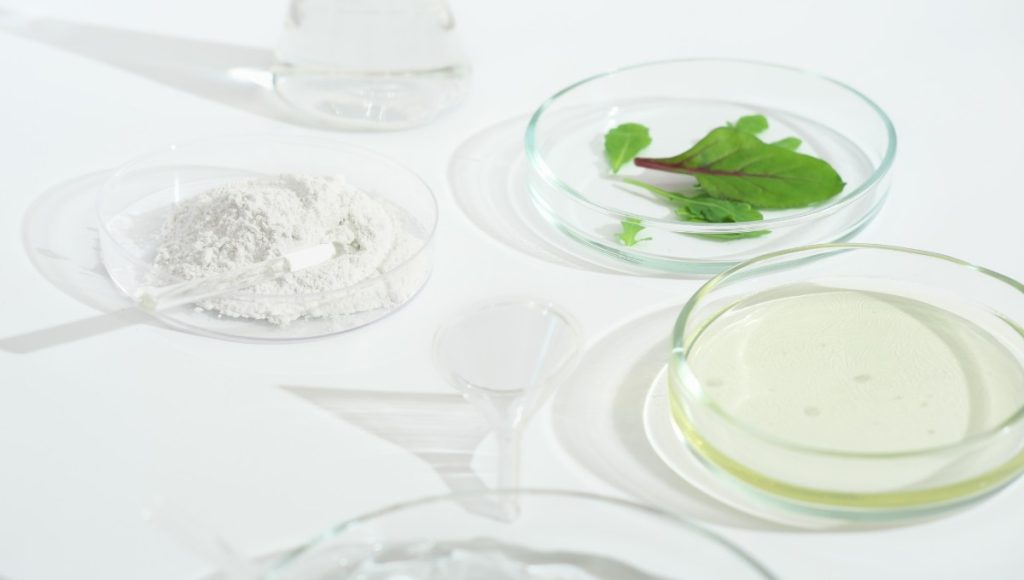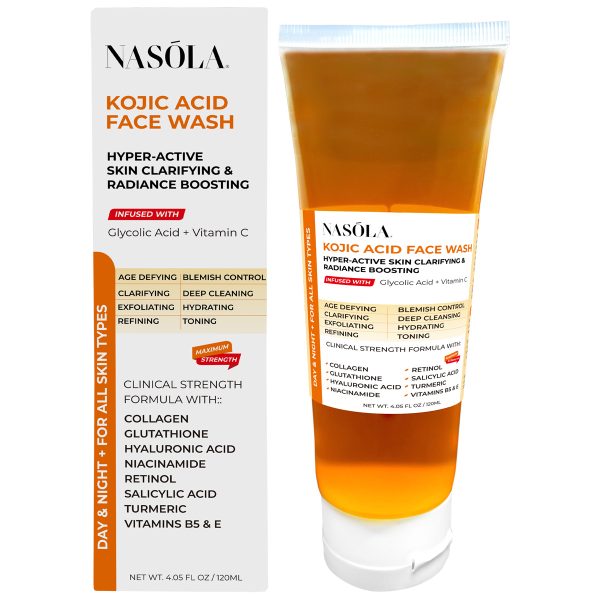id you know that Glycolic Acid Cleanser is like a secret weapon for achieving radiant skin? Yes, it’s true! This powerhouse ingredient, derived from sugarcane, works wonders in transforming your complexion. Picture it as your skin’s best friend, gently exfoliating away dead cells and impurities to reveal a brighter, smoother face. And the best part? It’s not just for the pros – anyone can incorporate it into their skincare routine for noticeable results.
So, buckle up and get ready to embark on a journey to uncover the magic of glycolic acid cleanser. With this post, we aim to explore the wonders that await your skin.
- The Science Behind Glycolic Acid Cleansers
- Top Benefits of Using a Glycolic Cleanser
- Best Glycolic Acid Facial Cleanser with Kojic Acid
- How to Choose the Right Cleanser with Glycolic Acid for Your Skin Type
- Combination skin
- Incorporating Glycolic Acid Cleansers into Your Skincare Routine
- Glycolic Facial Cleanser: Myths vs. Facts
- The Evolution of Glycolic Face Cleanser in Skincare
- Sensitive Skin and Glycolic Acid Cleansers
- In Conclusion
- Answering Your Questions
The Science Behind Glycolic Acid Cleansers

While traditional toners focus on simply balancing the skin’s pH, we’ll delve into the science behind the effectiveness of a glycolic acid cleanser, where science meets skincare to unlock radiant and healthy skin. Glycolic acid, a star ingredient renowned for its exfoliating prowess, works its magic at a cellular level to promote skin renewal and rejuvenation. As we delve deeper into the science behind glycolic acid cleansers, we’ll look into the mysteries of how this potent ingredient transforms your skin complexion.
At its core, glycolic acid is an alpha hydroxy acid (AHA) derived from sugar cane. Its small molecular size allows it to penetrate deeply into the skin, where it effectively dissolves the bonds that hold dead skin cells together. By exfoliating these dull and lifeless cells, glycolic acid reveals fresh, radiant skin underneath, resulting in a smoother, brighter, and more youthful complexion. Unlike other exfoliating acids like salicylic acid or lactic acid, glycolic acid boasts unparalleled efficacy in addressing a myriad of skin concerns. While salicylic acid primarily targets acne and unclogs pores, glycolic acid goes a step further by stimulating collagen production and reducing the appearance of fine lines and wrinkles.
One of the key benefits of glycolic acid cleansers is their versatility. Whether you have oily, dry, sensitive, or combination skin, glycolic acid cleansers can be tailored to meet your specific needs. For oily and acne-prone skin, glycolic acid helps regulate sebum production and prevent breakouts, while for dry and mature skin, it provides much-needed hydration and promotes a more youthful complexion.
Moreover, a glycolic acid cleanser can work synergistically with other skincare products to amplify their efficacy. By prepping the skin and removing impurities, glycolic acid cleansers create the perfect canvas for serums, moisturizers, and treatments to penetrate deeper into the skin and deliver maximum benefits.
Top Benefits of Using a Glycolic Cleanser

A glycolic cleanser offers a myriad of benefits that contribute to healthier, more radiant skin. Incorporating a glycolic cleanser into your skincare routine can yield remarkable results, including improved skin texture, reduced acne, and enhanced skin brightness. Let’s delve into these benefits to understand how glycolic cleansers can transform your complexion.
Firstly, a glycolic cleanser is renowned for its ability to improve skin texture. By gently exfoliating the skin’s surface, glycolic acid removes dead skin cells, unclogs pores, and promotes cell turnover. This process results in smoother, softer skin with a more refined texture, making it an ideal solution for addressing rough or uneven skin.
Moreover, glycolic cleansers are effective in combating acne and preventing future breakouts. The exfoliating properties of glycolic acid help to clear away pore-clogging impurities and excess oil, reducing the likelihood of blemishes. Additionally, glycolic acid possesses anti-inflammatory properties that can soothe existing acne and calm irritated skin, promoting a clearer complexion over time.
Furthermore, glycolic cleansers contribute to enhanced skin brightness and radiance. By eliminating dull, dead skin cells and promoting cell renewal, glycolic acid reveals fresher, brighter skin underneath. This renewed radiance can help to diminish the appearance of dark spots, hyperpigmentation, and sun damage, resulting in a more luminous complexion.
The benefits of using a glycolic cleanser extend beyond mere cleansing. From improving skin texture and reducing acne to enhancing skin brightness, glycolic cleansers offer a holistic approach to skincare that can rejuvenate and revitalize your complexion. For those seeking an effective glycolic cleanser, the Kojic Acid Face Wash Clarifying Cleanser Soap stands out as a top recommendation. Formulated with potent ingredients like glycolic acid and kojic acid, this cleanser delivers unparalleled results, leaving your skin feeling refreshed, renewed, and radiant.
Best Glycolic Acid Facial Cleanser with Kojic Acid

When it comes to achieving radiant and healthy skin, incorporating the right glycolic acid facial cleanser into your skincare routine is paramount. Let’s delve into why this cleanser stands out as the best glycolic acid facial cleanser, offering a multitude of benefits for your skin.
The Nasola Kojic Acid Face Wash is formulated with a blend of active ingredients, including glycolic acid, renowned for its exfoliating properties. Glycolic acid works by gently sloughing away dead skin cells, revealing brighter, smoother skin underneath. This key ingredient penetrates deep into the skin’s layers, effectively addressing concerns such as hyperpigmentation, sun damage, and uneven skin tone. By incorporating glycolic acid into its formula, the Nasola Kojic Acid Face Wash provides gentle yet effective exfoliation, promoting a radiant and youthful complexion.
Taking a deeper dive, the Nasola Kojic Acid Face Wash is enriched with Kojic Acid, another powerhouse ingredient known for its skin-brightening properties. Kojic acid works to inhibit melanin production, helping to fade dark spots, acne scars, and other forms of hyperpigmentation. By combining glycolic acid with Kojic Acid, this facial cleanser offers a comprehensive solution for achieving a luminous and even-toned complexion.
In addition to its active ingredients, the Nasola Kojic Acid Face Wash is formulated with gentle yet effective cleansing agents that remove impurities and excess oil without stripping the skin of its natural moisture. This ensures that your skin feels clean, refreshed, and hydrated after each use, making it suitable for daily use.
If you’re looking for the best glycolic acid facial cleanser to elevate your skincare routine, look no further than the Nasola Kojic Acid Face Wash. With its potent blend of glycolic acid, Kojic Acid, and other skin-loving ingredients, this cleanser offers unparalleled benefits for achieving a radiant and healthy complexion.
How to Choose the Right Cleanser with Glycolic Acid for Your Skin Type

Choosing the right cleanser with glycolic acid is a crucial step in any skincare routine, as it can significantly impact the health and appearance of your skin. Glycolic acid, renowned for its exfoliating properties, is a powerful ingredient that can effectively remove dead skin cells, unclog pores, and promote a brighter, smoother complexion. However, given its potency, it’s essential to select a cleanser tailored to your specific skin type to avoid irritation or adverse reactions.
Sensitive Skin
Sensitive skin is characterized by a heightened response to external factors such as skincare products, environmental pollutants, and even weather conditions. Individuals with sensitive skin often experience symptoms like redness, itching, burning sensations, and irritation when exposed to certain ingredients or harsh chemicals.
When selecting a cleanser with glycolic acid for sensitive skin, the primary goal is to find a gentle yet effective formula that provides the desired benefits without causing undue irritation. Opting for a cleanser with a lower concentration of glycolic acid is advisable, as it reduces the risk of over-exfoliation and minimizes the likelihood of adverse reactions.
Normal Skin
Normal skin is often considered the ideal skin type, as it strikes a balance between oily and dry skin. Individuals with normal skin typically have small pores, a smooth texture, and minimal sensitivity.
When selecting a glycolic acid cleanser for normal skin, it’s essential to look for products that offer a balanced combination of exfoliation and hydration. Cleansers with a moderate concentration of glycolic acid are ideal, as they can effectively remove dead skin cells without stripping the skin of its natural moisture barrier.
Oily Skin
Oily skin can often be a challenge to manage, as it tends to produce excess sebum, leading to shine, enlarged pores, and an increased risk of acne breakouts. Fortunately, glycolic acid cleansers can be a game-changer for those with oily skin, as they help control sebum production and effectively unclog pores, leading to a clearer and more balanced complexion.
In addition to glycolic acid, look for products that contain other beneficial ingredients for oily skin, such as salicylic acid or tea tree oil. Salicylic acid is a beta-hydroxy acid (BHA) that penetrates deep into the pores, helping to dissolve oil and unclog pores, making it an excellent complement to glycolic acid in targeting acne and breakouts.
Dry Skin
Dry skin requires special care and attention to ensure it remains hydrated, nourished, and comfortable, especially when choosing a cleanser with glycolic acid. Look for cleansers specifically formulated for dry skin that contain hydrating ingredients such as hyaluronic acid, glycerin, or botanical extracts known for their moisturizing properties.
These ingredients work to attract and retain moisture in the skin, helping to alleviate dryness and restore suppleness. Additionally, opt for cleansers with a pH-balanced formula that helps maintain the skin’s natural acidity, supporting the skin’s moisture barrier and preventing disruption to its delicate balance, thus reducing the risk of dryness and irritation.
Combination skin
Combination skin, characterized by having both oily and dry areas on the face, presents unique challenges in skincare, requiring a balanced approach to maintain hydration while controlling excess oil production and preventing breakouts. When selecting a cleanser with glycolic acid for combination skin, it’s crucial to find a product offering a harmonious blend of exfoliation and hydration, specifically formulated to cater to combination skin types.
In conclusion, choosing the right cleanser with glycolic acid tailored to your skin type is essential for achieving a healthy and radiant complexion. Whether you have sensitive, normal, oily, dry, or combination skin, there are customized options available to address your specific needs effectively.
Incorporating Glycolic Acid Cleansers into Your Skincare Routine

Integrating a glycolic acid cleanser into your skincare regimen can be a game-changer for achieving smoother, brighter skin. To start, it’s essential to understand how and when to use it effectively. Consider incorporating the glycolic acid cleanser into your evening skincare routine, as it can effectively remove makeup, dirt, and excess oil accumulated throughout the day. Begin by using the cleanser two to three times a week. This allows your skin to adjust to the exfoliating properties of glycolic acid without overloading it.
When using a glycolic acid cleanser, it’s crucial to follow up with hydrating products to replenish moisture and maintain skin balance. After cleansing, apply a hydrating serum or moisturizer to lock in moisture and keep your skin hydrated. While glycolic acid cleansers can work wonders for your skin, it’s essential to avoid over-exfoliation. Overuse of exfoliating products can lead to irritation, sensitivity, and even damage to the skin barrier. To prevent this, start with a lower frequency of use and gradually increase as your skin adjusts.
Incorporating a glycolic acid cleanser into your skincare routine can also enhance the effectiveness of other products. Glycolic acid helps to remove dead skin cells and unclog pores, allowing other skincare products to penetrate deeper into the skin.
When choosing a glycolic acid cleanser, look for products with additional beneficial ingredients, such as hyaluronic acid, antioxidants, and soothing botanicals. These ingredients can further enhance the benefits of the cleanser and provide additional skincare benefits, such as hydration, antioxidant protection, and soothing properties.
Overall, incorporating a glycolic acid cleanser into your skincare routine can transform your complexion, leaving you with smoother, brighter, and more radiant skin. By using it strategically and in conjunction with other hydrating and nourishing products, you can achieve optimal results and maintain a healthy, glowing complexion.
Glycolic Facial Cleanser: Myths vs. Facts

In the world of skincare, glycolic facial cleansers are no exception. Let’s address and correct some of the most pervasive misconceptions surrounding these potent skincare products. Firstly, there’s a widespread belief that glycolic facial cleansers thin the skin over time. However, this assertion is unfounded. Glycolic acid, the primary active ingredient in these cleansers, functions by delicately exfoliating the outer layer of dead skin cells, prompting cellular turnover, and unveiling fresh, rejuvenated skin underneath.
Contrary to thinning the skin, this process actually thickens it over time, yielding a smoother, more youthful complexion. Another prevalent misconception is that glycolic facial cleansers are solely tailored for aging skin. While glycolic acid is indeed revered for its anti-aging properties, its benefits transcend age-specific concerns.
Glycolic facial cleansers boast a versatile array of benefits, from combating acne and hyperpigmentation to refining uneven texture and illuminating dull skin. This adaptability renders them suitable for individuals of all ages and skin types, dispelling the notion that they’re exclusively reserved for mature skin. By debunking these myths and presenting factual information, our aim is to empower readers with the insights necessary to make informed choices regarding their skincare regimen. Whether one seeks to reverse the signs of aging or simply enhance their skin’s natural luminosity, integrating a glycolic facial cleanser into their routine can yield tangible results and bestow upon them a complexion that exudes health and vitality.
In addition to dispelling myths, it’s crucial to understand the science behind glycolic facial cleansers to appreciate their efficacy fully. Glycolic acid, a type of alpha hydroxy acid (AHA), boasts a small molecular size that enables it to penetrate deeply into the skin’s layers. Once absorbed, it works to dissolve the bonds between dead skin cells, facilitating their shedding and revealing the underlying fresh skin.
The Evolution of Glycolic Face Cleanser in Skincare

Glycolic acid, a powerful yet gentle exfoliant derived from sugarcane, has a rich history in skincare that dates back centuries. Today, a glycolic face cleanser harnesses the exfoliating prowess of this versatile ingredient, offering users a convenient way to achieve a radiant complexion. Initially discovered for its skin-rejuvenating properties, glycolic acid has undergone a remarkable evolution, transforming from a niche ingredient to a staple in modern beauty routines.
Historically, glycolic acid was primarily used in dermatological treatments, such as chemical peels, to address various skin concerns, including acne, hyperpigmentation, and signs of aging. However, as research on its benefits expanded, skincare brands began incorporating glycolic acid into their products, particularly facial cleansers.
Over the years, advancements in formulation technology have led to the development of innovative glycolic face cleansers that cater to diverse skin types and concerns. These cleansers not only effectively remove impurities and excess oil but also provide gentle exfoliation, resulting in smoother, brighter, and more youthful-looking skin. Additionally, many glycolic face cleansers now feature hydrating and soothing ingredients to counteract any potential dryness or irritation, making them suitable for daily use.
Looking ahead, the future of glycolic face cleansers is promising, with continued innovation driving the development of even more advanced formulations. Expect to see cleansers that combine glycolic acid with other potent ingredients, such as antioxidants and peptides, to provide comprehensive skincare benefits.
The evolution of glycolic face cleansers in skincare has been remarkable, with advancements in formulation technology and consumer preferences driving their popularity. From their origins in dermatological treatments to their current status as must-have products in beauty routines, glycolic face cleansers continue to redefine the way we approach skincare. As innovations continue to emerge and future trends shape the industry, glycolic face cleansers are poised to remain a cornerstone of effective and accessible skincare regimens.
Sensitive Skin and Glycolic Acid Cleansers

Sensitive skin requires extra care when incorporating a glycolic acid cleanser into a skincare routine. While glycolic acid offers numerous benefits, including exfoliation and skin rejuvenation, its potent nature can potentially cause irritation, especially for those with sensitive skin. Therefore, it’s essential to take precautions to ensure safe and effective use of glycolic acid cleansers without exacerbating sensitivity.
First and foremost, individuals with sensitive skin should opt for glycolic acid cleansers with lower concentrations to minimize the risk of irritation. Starting with a gentle formulation, typically containing a lower percentage of glycolic acid, allows the skin to acclimate to the exfoliating properties of the ingredient gradually.
When using a glycolic acid cleanser for the first time, it’s advisable to limit the frequency of application to once or twice a week, gradually increasing the usage as tolerated by the skin. Over Exfoliation can compromise the skin’s barrier function and lead to increased sensitivity, so it’s essential to listen to your skin’s response and adjust accordingly. In addition to adjusting the frequency of use, sensitive skin types may benefit from incorporating hydrating and soothing products into their skincare routine to mitigate potential irritation caused by glycolic acid cleansers.
Lastly, always remember to follow up with a broad-spectrum sunscreen during the day when using glycolic acid cleansers, as they can increase the skin’s sensitivity to the sun’s harmful UV rays. Sun protection is crucial for maintaining skin health and preventing further irritation or damage.
By following these tips for safe use, individuals with sensitive skin can harness the benefits of glycolic acid cleansers without compromising the integrity of their skin barrier. With patience, consistency, and proper precautions, glycolic acid cleansers can become valuable allies in achieving healthy, radiant skin for those with sensitive skin types.
In Conclusion

This journey with glycolic acid cleanser has been enlightening. Throughout this journey, we’ve dispelled myths, delved into the science underpinning these potent skincare solutions, and traced their evolution within modern skincare routines. Armed with knowledge about their benefits and safe usage, you’re now ready to harness the transformative power of glycolic acid cleansers for radiant skin.
Whether you’re tackling signs of aging or seeking to enhance your skin’s natural luminosity, integrating a glycolic acid cleanser into your routine holds the promise of profound transformation. Embrace this path towards healthier, more vibrant skin, fortified by informed decisions and effective skincare practices.
Answering Your Questions

Curious about incorporating glycolic acid cleansers into your skincare routine? We’ve got you covered with answers to some of the most commonly asked questions about glycolic acid skincare products.
Glycolic acid cleansers work by gently exfoliating the skin, removing dead cells and impurities, thus promoting a brighter and more even complexion. For an effective glycolic acid cleanser, consider trying the Kojic Acid Face Wash Clarifying Cleanser Soap.
Yes, you can use a glycolic acid cleanser every day, but it’s important to start slowly, especially if you have sensitive skin.
Common side effects of glycolic acid include mild irritation, redness, and peeling, especially when you first start using it. To minimize potential side effects, start with a gentle glycolic acid cleanser like the Kojic Acid Face Wash Clarifying Cleanser Soap.
Common side effects of glycolic acid include mild irritation, redness, and peeling, especially when you first start using it.
Yes, using salicylic acid as a cleanser and glycolic acid as a toner can be an effective combination for oily and acne-prone skin.
Yes, you can use a glycolic acid toner after using a salicylic acid cleanser. The salicylic acid cleanser will help to remove excess oil and impurities, allowing the glycolic acid toner to better penetrate the skin and provide its exfoliating benefits.
Yes, you can still use retinol after cleansing with a glycolic acid cleanser. However, it’s important to wait a few minutes after cleansing to allow your skin to dry completely before applying retinol to avoid irritation.
For an effective and budget-friendly option, the Kojic Acid Face Wash Clarifying Cleanser Soap works best. It combines the benefits of glycolic acid with other skin-loving ingredients to cleanse, exfoliate, and brighten the skin without breaking the bank.
To use glycolic acid on the face, start by cleansing your skin with a glycolic acid cleanser, then follow up with a toner or serum containing glycolic acid. Use sunscreen during the day as glycolic acid can increase sun sensitivity, and start slowly if you have sensitive skin.



